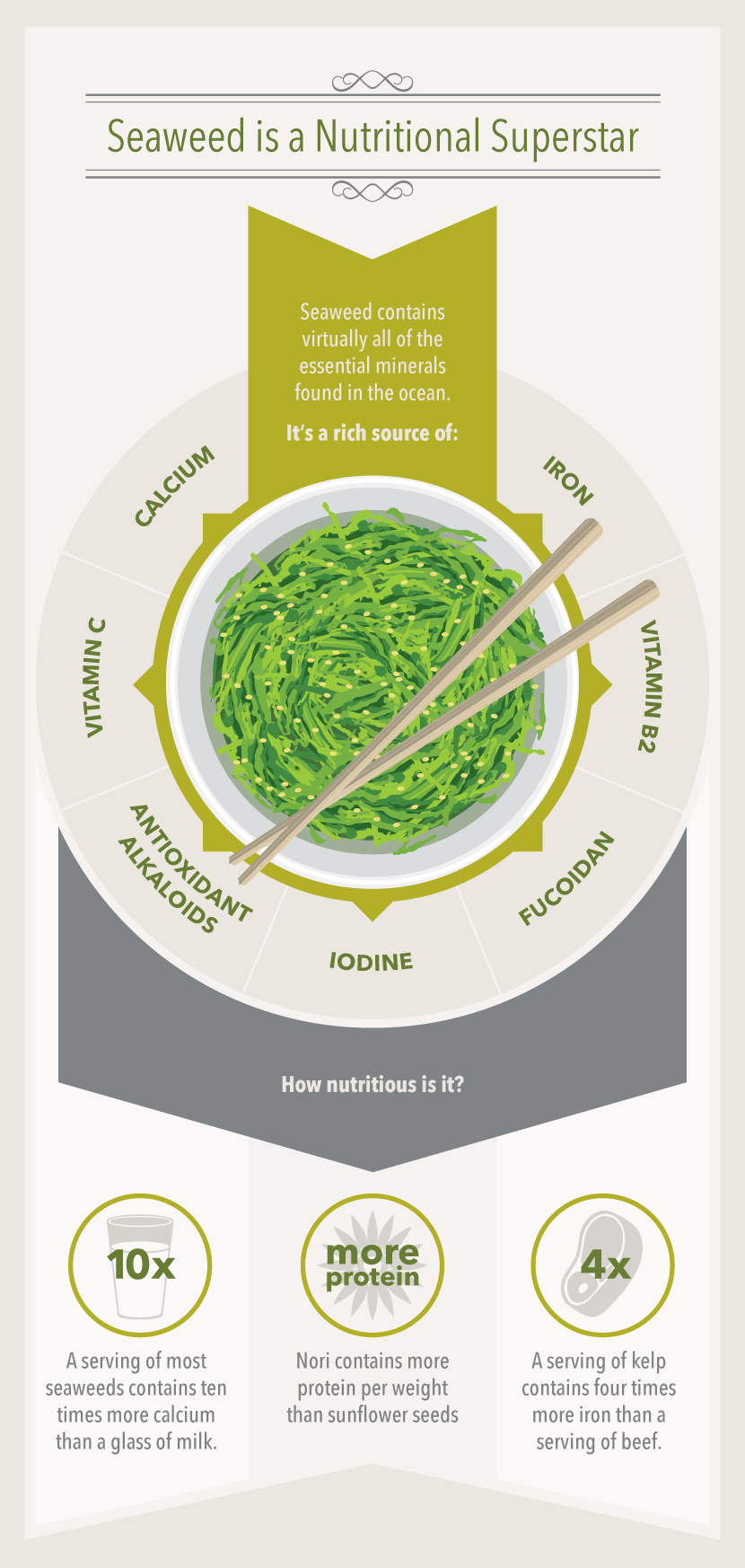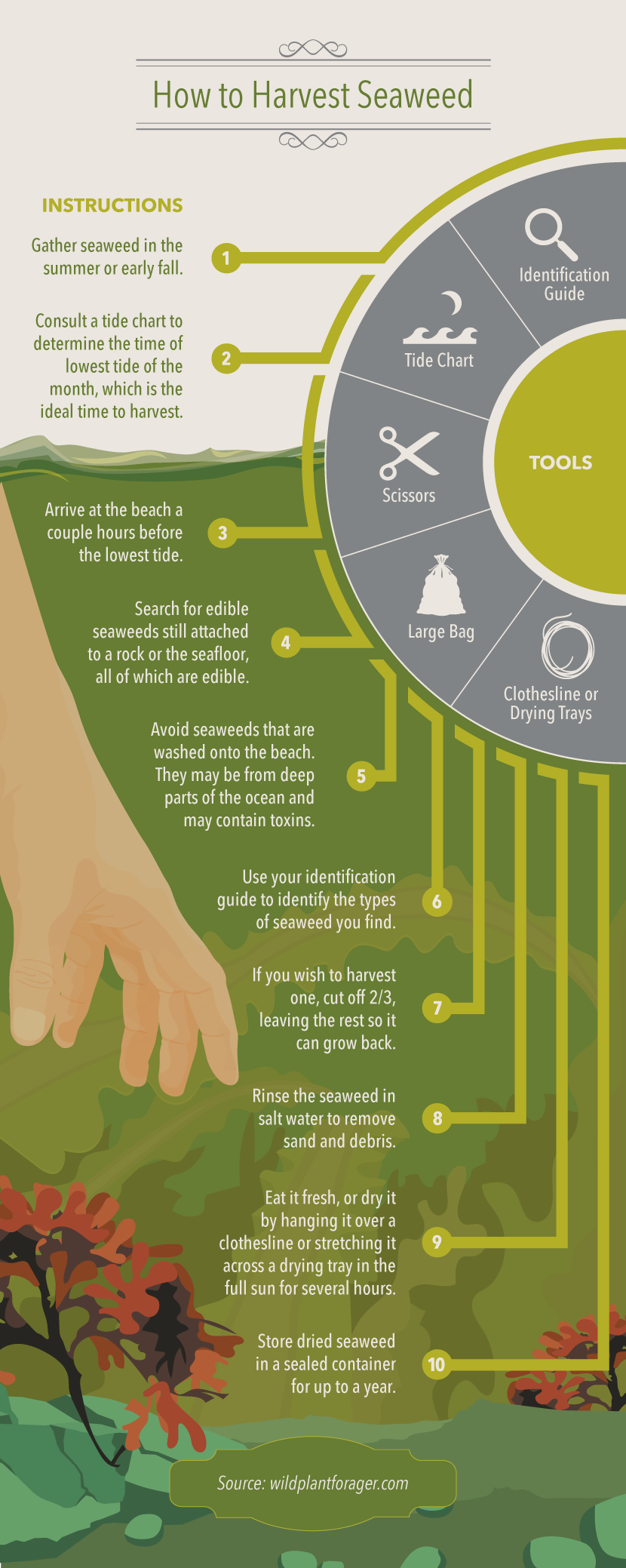Superfood of the Sea: A Guide to Eating Seaweed
Some of the most nutritious vegetables aren’t plants, and they don’t grow in soil or even on land. We call these vegetables “seaweed,” however that term is a little misleading. It actually refers to about 10,000 species of edible marine algae. People worldwide have eaten various types of seaweed for thousands of years, and it’s still a staple in Korea, Japan, and many other parts of the globe.
Seaweed is packed with minerals and other nutrients. It was traditionally used as a medicine, and modern studies confirm it has antiviral and anticancer properties. Have you been skipping this nutritious food because it seems strange or exotic? Keep reading to learn about popular types of seaweed and the benefits of eating them. Also, discover delicious ways to eat seaweed, and find out how to harvest it if you live near a shoreline.

Nutritional Superstar
You may eat seaweed regularly without knowing it. Not only is it a main ingredient in many Asian dishes, it’s also used as a stabilizer and thickener in many popular foods. (Here’s looking at you, ice cream.) Anytime you see the ingredients agar, alginate, or carrageenan, you’re eating a derivative of seaweed. But if that’s the only seaweed you’re eating, you’re missing out on the nutritional and health benefits of ingesting seaweed in its whole form.
Most seaweed is rich in antioxidants, protein, fiber, and a wide variety of minerals that are concentrated in seawater, including calcium, iron, potassium, and magnesium. Moreover, it’s the richest dietary source of iodine, a trace mineral that plays an important role in the healthy functioning of the nervous, immune, and endocrine systems.
The Importance of Iodine
Today, table salt contains supplemental iodine because of a 1922 public health initiative undertaken to correct an epidemic of severe iodine deficiency in the early 1900s. However, many people do not get enough of this crucial nutrient.
About one-third of pregnant women in the U.S. are iodine-deficient, according to a 2014 article published in the journal Pediatrics. That’s an alarming statistic because iodine deficiency can harm the cognitive development of a fetus or breastfeeding infant and the health of the mother.
Iodine is also critical for the health of the thyroid, the small gland in your neck that produces and regulates hormones. Alarmingly, thyroid disorders are increasingly common, and many doctors warn of a modern epidemic of thyroid disease, especially among women.
Why are many people iodine-deficient today? The primary reason is that many soils are deficient in it. Furthermore, people may be eating less iodized salt today than in the mid-20th century because we eat more processed food. Seventy percent of the modern American diet is processed, according to one study. Processed food contains a lot of salt, but manufacturers usually add non-iodized salt because it’s cheaper. In addition, many people avoid table salt for health reasons.
The bottom line? You may need more iodine than you’re currently ingesting, and seaweed is an excellent natural source. In fact, one type of seaweed is so rich in iodine, you should take a few precautions when eating it.

Safe Snacking
Kombu, a type of kelp, contains the most iodine per serving of the popular types of seaweed. One gram contains 2,353 micrograms of iodine, nearly 16 times the quantity recommended for daily intake. That means you could ingest a toxic dose of iodine if you eat too much raw kombu.
However, a few simple preparation methods eliminate the risk:
If these ways of preparing kombu sound familiar, that’s because the Japanese use them to make miso soup. The broth is made with boiled kombu, and the soup is often served with tofu.
Other types of kelp, such as arame and wakame, contain far less iodine than kombu. However, you could ingest too much iodine if you eat large amounts over long periods. Enjoy these types of kelp uncooked, but stick to moderate portions of 20 grams or less per day.
You may wish to avoid one type of seaweed altogether. Hijicki, a red seaweed, is sometimes contaminated with arsenic. Government agencies in several countries, including Canada, advise against consuming it.
One more precaution: If you already have a thyroid condition, talk to your doctor before consuming seaweed.
Nutritious and Delicious
Don’t let those safeguards stop you from noshing on seaweed. For the majority of healthy people, it’s safe and beneficial to eat seaweed in moderate amounts as part of a varied diet. Moreover, it has a salty, meaty flavor many people love. If you don’t like it at first, try different varieties and preparation methods.
Traditional Japanese dishes, such as miso, sushi, and seaweed salads are delicious. Also, experiment with these simple ways of using seaweed in everyday cooking:

Good for You, Good for the Earth
Seaweed is not only tasty, it’s eco-friendly. It grows incredibly quickly, and it’s abundant. Moreover, it does not require our dwindling resources of fresh water and arable land. Thus, eating more of it could prevent some of the environmental damage caused by land-based agriculture, such as deforestation, soil erosion, and biodiversity loss.
Furthermore, seaweed scrubs pollutants such as nitrogen and mercury from the environment. And it absorbs roughly five times more carbon dioxide from the atmosphere as land-based plants absorb. Scientists are even experimenting with cultivating it to counteract climate change.
Moreover, there’s a free and eco-friendly way to consume seaweed. Harvest your own! If you live near a shoreline, as nearly half of the world’s population does, it’s easy to gather, dry, and store your own seaweed. Take home extra to use as a nutritious, eco-friendly garden fertilizer.

Don’t miss out on all the benefits of eating seaweed. This nutritional superstar is not only tasty and nutritious, it may be the solution to some of our biggest environmental challenges.
- http://www.seaweed.ie/algae/seaweeds.php
- https://www.ncbi.nlm.nih.gov/pmc/articles/PMC2596289/
- https://www.researchgate.net/publication/260369735_Biomedical_Properties_of_Edible_Seaweed_in_Cancer_Therapy_and_Chemoprevention_Trials_A_Review
- http://www.webmd.com/baby/news/20140526/iodine-deficiency-common-in-pregnancy-pediatricians-warn#1
- http://link.springer.com/chapter/10.1007%2F978-94-007-4375-5_17
- https://thyroidresearchjournal.biomedcentral.com/articles/10.1186/1756-6614-4-14
- http://www.thyroid.org/media-main/about-hypothyroidism/
- http://www.marketplace.org/2013/03/12/life/big-book/processed-foods-make-70-percent-us-diet
- http://journals.lww.com/jonmd/Citation/1919/11000/Epidemic_of_Goiter_.29.aspx
- https://www.ncbi.nlm.nih.gov/pmc/articles/PMC3204293/
- https://examine.com/nutrition/how-can-i-safely-consume-seaweed/
- http://www.inspection.gc.ca/food/information-for-consumers/fact-sheets-and-infographics/specific-products-and-risks/chemical-hazards/inorganic-arsenic/eng/1332268146718/1332268231124
- https://www.ncbi.nlm.nih.gov/pmc/articles/PMC3976240/
- http://www.dailymail.co.uk/health/article-2013213/Want-cut-salt-Try-seaweed-granules-chips-instead.html
- http://www.mv.helsinki.fi/home/tammisol/BiodivLyhAmmann04.pdf
- https://www.theatlantic.com/international/archive/2011/11/the-coming-green-wave-ocean-farming-to-fight-climate-change/248750/
- http://learn.eartheasy.com/2010/09/how-to-use-seaweed-to-mulch-your-garden/
- http://www.ryandrum.com/seaweeds.htm
- http://www.prb.org/Publications/Reports/2003/RippleEffectsPopulationandCoastalRegions.aspx
Embed the article on your site

























































